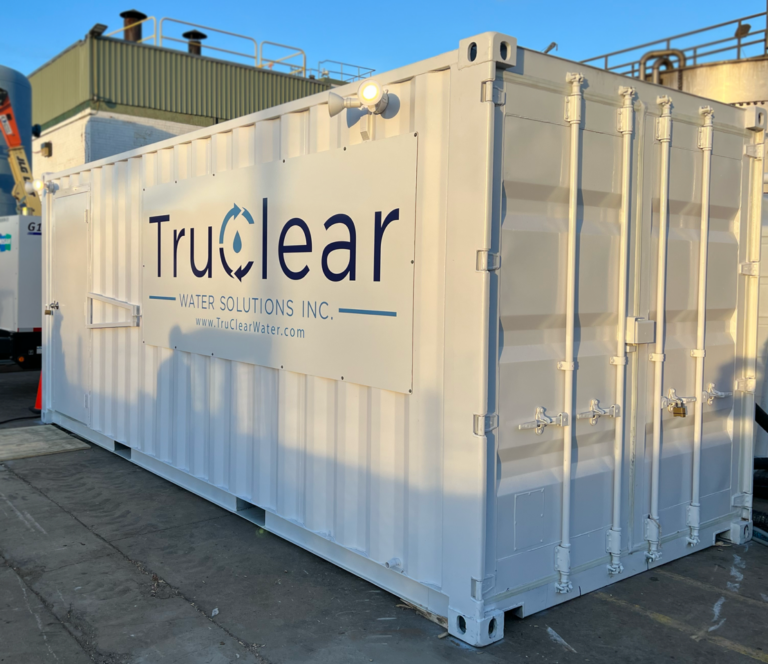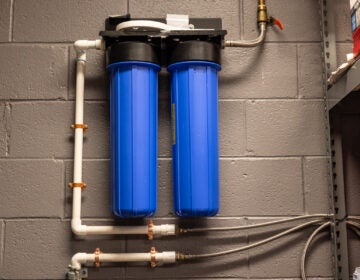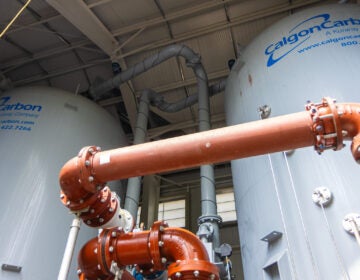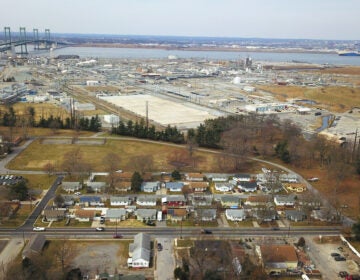Making a ‘forever chemical’ no longer forever: Bucks County officials propose new way to remove PFAS
Bucks County Water and Sewer Authority officials say technology utilizing low-voltage electricity is safer for the environment.

The Bucks County Water and Sewer Authority hopes to become the first water provider to use low-voltage electricity to break down PFAS. The technology, designed by Texas company TruClear Water Solutions, does not require water providers to dispose of leftover materials and contaminants. (TruClear Water Solutions)
From Philly and the Pa. suburbs to South Jersey and Delaware, what would you like WHYY News to cover? Let us know!
A Bucks County drinking water provider wants to take a novel approach to remove PFAS after detecting the toxic chemicals in New Hope’s and Solebury’s water wells, at levels above new state and federal regulations.
Instead of using the more common carbon filtration method, the Bucks County Water and Sewer Authority (BCWSA) hopes to become the first water provider to use low-voltage electricity to break down the “forever chemicals.”
PFAS, a large class of chemicals used in hundreds of everyday products and firefighting foam, have polluted drinking water across the country and the Philadelphia region.
The compounds can stay in the environment, and the human bloodstream, for years. The chemicals have been linked to numerous health problems, including thyroid disease, developmental delays in children and some cancers.
Unlike other methods of removing PFAS, the technology, designed by Texas company TruClear Water Solutions, does not require water providers to dispose of leftover materials and contaminants.
“It breaks the compounds down and makes them inert, so that they aren’t compounds anymore, and not the cancer-causing agents,” said Erin Schulberger, director of environmental compliance for BCWSA. “There’s no waste stream, there’s no harm to the environment with disposal.”
BCWSA first detected PFAS in its New Hope wells in 2016, before federal and state regulations were enacted. This year, the U.S. Environmental Protection Agency implemented the first federal limits on PFAS in drinking water. Water providers have up to five years to test and treat the chemicals to almost zero.
BCWSA’s New Hope and Solebury systems are among almost 200 in the state that contained PFAS levels above the new federal limits when tested between January and March this year. The New Hope and Solebury systems also tested above state limits, which are less stringent than federal requirements.
Officials do not know the source of contamination in the New Hope and Solebury groundwater supplies. BCWSA, which serves customers in Bucks, Montgomery and Chester counties, has not detected high levels of PFAS in any of its other supplies — which, unlike New Hope and Solebury, come from the Delaware River.
TruClear’s technology, known as Advanced Molecular Oxidation, has previously been used in the oil and gas and food industries. The filtration process, which results in the molecular dissociation of pollutants, is an environmentally friendly alternative to the current mainstay of removing PFAS — granular activated carbon (GAC).
In the most simplest terms, GAC technology works when the unwanted compounds are absorbed by the carbon.
However, there are potential environmental costs to that filtration process. To produce activated carbon, which is made from coal, it must be subjected to significantly high temperatures — potentially releasing carbon dioxide.
Once the activated carbon is used to eliminate the PFAS, the materials must be disposed of. That’s often done via incineration, or by sending it to a landfill, potentially releasing more carbon dioxide, as well as the leftover chemicals — something BCWSA officials say they want to avoid.
“If it leaks out … these forever chemicals could still be polluting the water source, the air,” said BCWSA CEO Ben Jones.
TruClear’s technology aims to make PFAS inert in the water itself, rather than removing the chemicals and transferring them to the incinerator or landfill.
“What we’re striving to do is to make a ‘forever chemical’ no longer forever,” Jones said.
Though scientists acknowledge the need for effective filtration systems that don’t harm the environment, some have voiced concerns about destructive technology. Seetha Coleman-Kammula, president and executive director of PFAS Solutions in New Castle, Del., said there’s potential for PFAS to transform into other unwanted contaminants in the process.
“[The process] can chop them into shorter bits, which can come together and become longer PFAS. Are we just generating the next wave of problems?” she said. “[TruClear is] trying to do chemistry in the water itself. To me, that’s the most concerning part of the decision.”
Coleman-Kammula said it’s important companies such as TruClear analyze the water after it has gone through the filtration process to determine there are no chemical reactions that create further pollutants.
TruClear did not immediately respond to questions about these concerns.
The EPA does not need to approve any filtration system before it goes on the market. However, BCWSA must receive approval from the Pennsylvania Department of Environmental Protection before it can use the filtration system.
BCWSA said independent lab testing found the technology can remove about 90-100% of PFAS. In a statement, DEP said it cannot comment on the effectiveness of the proposed treatment until the completion and review of the pilot study.
Jones said the system, which will cost BCWSA more than $700,000 a year, is more affordable than carbon filtration. He said he hopes settlement dollars from a Bucks County lawsuit against PFAS manufacturers will offset the costs. Still, water bills will likely rise by about 4%, Jones said.
“No matter what treatment we picked in this particular case, we would have to raise rates in order to cover the cost of these treatments, because it wasn’t originally part of our operating expenses,” he said.

Get daily updates from WHYY News!
WHYY is your source for fact-based, in-depth journalism and information. As a nonprofit organization, we rely on financial support from readers like you. Please give today.







